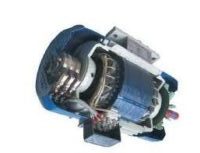Difference between Variable reluctance stepper motor and PM stepper motor
In this article, we will know about the Difference between variable reluctance motor and permanent magnet stepper motor. We will also know about the working of stepper motor.From this article we will know about the what is basic comparision between reluctance motor and permanent magnet stepper motor


Stepper Motor Working
A Stepper motor is a brush less dc motor whose rotor rotates in discrete angular increments when its stator windings are energized in a programmed manner. Rotational occurs because of magnetic interaction between rotor poles and poles of the sequentially energized stator windings. The rotor has no electrical windings, but has salient and/ or magnetized poles.
Difference between variable reluctance motor and permanent magnet stepper motor
| Variable Reluctance Stepper Motor | Permanent Magnet Stepper Motor |
| This type stepper motor is not magnetized. | Permanent Magnet stepper motor rotor is magnetized. |
| In this type motor have high torque to inertia ratio. | It have also high torque to inertia ratio |
| It have high rates of acceleration | It s Acceleration is slow It is basic difference between variable reluctance stepper motor and permanent magnet stepper motor. |
| Variable reluctance stepper motor dynamic response is fast. | Permanent magnet stepper motor have very slow dynamic response |
| It have maximum stepping rate (1200 Pulse/sec) | Its maximum stepping rate (300Pulse/sec) |
| It can be manufactured for large no. of poles | It cannot be manufactured for large no. of poles. |
| Variable stepper motor has very small step angle is possible. | Permanent magnet stepper motor has high step angle (30 to 90 degree). |
| It is doesn’t have a decent torque | Its Rotor has smooth cylindrical type of construction. |
Variable Reluctance stepper motor
In this type of stator motor there is no permanent magnet either on the stator of on the rotor, The stator and rotor are of salient pole type and mode of soft iron stamping.
The stepper has a number of wound poles but the rotor has no winding and is cylindrical the number of poles on the stator is an even multiple of the number of phases for which the stator windings are wound. The number of phases on the stator must be at least three for bidirectional control of the stepper motor.
Application of VR Stepper Motor
Variable reluctance stepper motors are quite inexpensive and suitable for light duties such as those in computer and industrial instrument systems.
This is also known as switched reluctance stepper motor. This type of stepper motor consists a salient pole stator with concentrated winding and a salient pole rotor. The rotor is made of ferromagnetic
Laminations and has no winding. The operation of VRSM depends on various reluctance positions of rotor with respect to stator. When one phase of the stator is excited, it produces a magnetic field which causes the rotor movement through a single step in the direction of minimum reluctance after that other phases are energized in sequence one after the other with the help of switches.
Hence, these are some basic Difference between variable reluctance motor and permanent magnet stepper motor. From this article we have learn also about working of stepper motor. If you will find any incorrect in above article you must comment below in comment box
